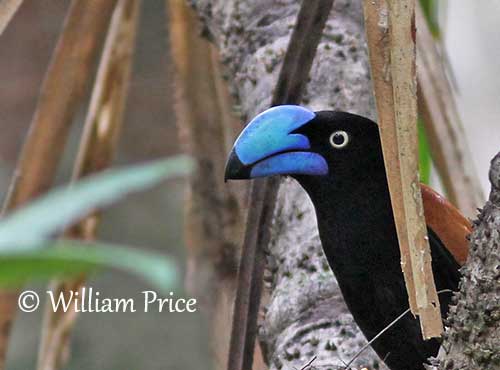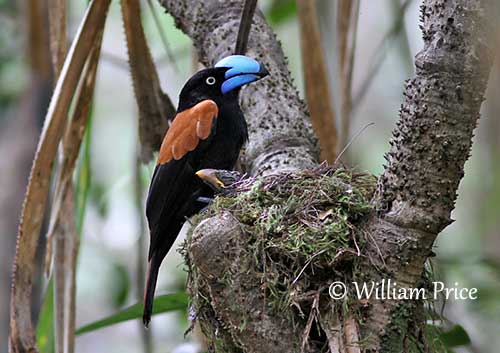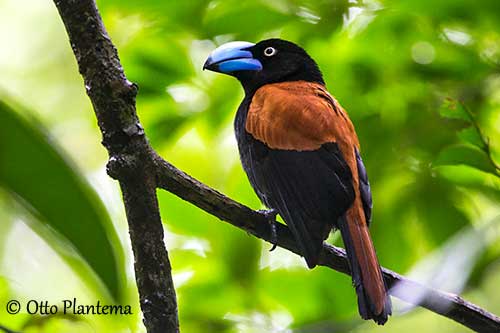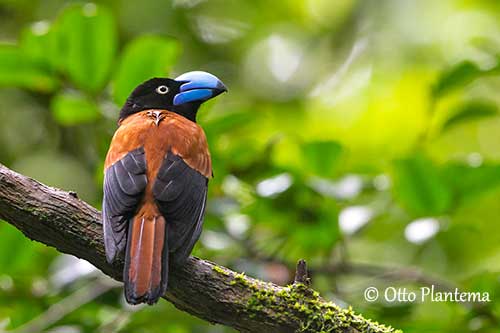
Fr: Eurycère de Prévost
Ang: Helmet Vanga
All: Helmvanga
Esp: Vanga de Casco
Ita: Vanga dall'elmo
Nd: Helmvanga
Sd: hjälmvanga
Mal: patsatsatrala, Siketribe
Photographers:
Otto Plantema
Trips around the world
William Price
PBase-tereksandpiper & Flickr William Price
Text by Nicole Bouglouan
Sources :
HANDBOOK OF THE BIRDS OF THE WORLD Vol 14 by Josep del Hoyo-Andrew Elliot-David Christie - Lynx Edicions – ISBN: 9788496553507
L’ENCYCLOPEDIE MONDIALE DES OISEAUX - Dr Christopher M. Perrins - BORDAS - ISBN: 2040185607
Wikipedia, the free encyclopaedia
African Bird Club – Working for birds and conservation in Africa
Creagus – Bird Families of the World – Vangas - Vanginae
Birds of Madagascar and the Indian Ocean Islands Par Roger Safford,Adrian Skerrett,Frank Hawkins
MacroBird - The Helmet Vanga (Euryceros prevostii)
Helmet Vanga
Euryceros prevostii
Passeriformes Order – Vangidae Family
INTRODUCTION:
The Helmet Vanga is the only member of the genus Euryceros. This strange and beautiful bird is unmistakable with its massive, arched, hooked blue bill. This bird is very secretive and hard to find, often sitting motionless in tree for long periods. The large bill allows this species to feed on large preys such as insects, amphibians and lizards.
The Helmet Vanga frequents dense, evergreen humid forests between 400 and 900 metres of elevation, but it can be seen lower and higher sometimes. It is endemic to Madagascar.
This species is threatened by habitat loss through clearance of forest at low elevation. It cannot survive outside this habitat, and it is currently listed as Vulnerable.

CALLS AND SONGS: SOUNDS BY XENO-CANTO
The Helmet Vanga gives short whistle “phu” as contact call, but we can also hear higher “tseeah” and “eesh” notes. When the bird is threatened, it utters a harsh “treh treh treh”. The contact call between mates while moving through the forest is a nasal “hink hink hink”.
The song is usually heard at dawn, a long, slightly descending, quavering “pip pi pi pi pipipipipiperperperperper…” and it also utters a medium-pitched, short warbled phrase, followed by a slightly higher second sequence.
BEHAVIOUR IN THE WILD:
The Helmet Vanga feeds on large insects such as cockroaches, moths, butterflies, crickets and beetles. It also takes a variety of invertebrates and vertebrates including snails, spiders, frogs, geckos, chameleons and lizards. The larger prey are dismembered before to be swallowed.
It forages between 3 and 10 metres above the ground within the forest. The prey are caught from leaves and branches by sallies, or taken on the ground. It hunts by gleaning, snatching and hawking, or jumping onto still prey before sizing it.
The Helmet Vanga is an arboreal species, spending most of the time in foraging in trees. It can be seen alone or in small groups of 5-10 vanga species, sometimes with other bird species.
The Helmet Vanga is monogamous and breeds during the southern summer. There is usually only one clutch, but the pair may make a second attempt if the first fails. Both mates share the task of nest-building and all the nesting duties.
The courtship displays are unknown, but we can suggest that the massive blue bill and the contrasted plumage are enhanced by adapted postures. From an observation, courtship feeding occurs prior to copulation, but there were no calls or song while the birds were mating.
The Helmet Vanga is sedentary. It performs short flights between foraging sites, and hawks insects in flight.

REPRODUCTION OF THIS SPECIES:
The breeding season takes place during the southern summer, between September/October and December/January.
Both mates build the nest, a cup-shaped structure placed in tree-fork, about 2-4 metres above the ground. The nest is made with mosses and plant fibers woven with twigs.
The female lays 2-3 pale pinkish eggs with dark red mottling. The duration of the incubation is unknown, but both mates incubate.
At hatching, the chicks are naked. But after 7-8 days, the plumage is growing slowly, mostly dark brown and without rufous. The bill is pale horn and smaller than in adults.
The young leave the nest 17 days after hatching, indicating that the incubation may last about 15-20 days.
The adults defend both nest and chicks against predators such as Crested Drongo and Blue Coua, by attacking them while calling loudly.
PROTECTION / THREATS / STATUS:
The Helmet Vanga has restricted range and patchy distribution. It is threatened by habitat loss due to forest clearance for exploitation of timber and agriculture expansion.
It is found in several protected areas, but the population is roughly estimated to number 6,000/15,000 mature individuals and is still declining.
The Helmet Vanga is currently listed as Vulnerable.

DESCRIPTION OF THE BIRD:
Biometrics:
Length: 28-31 cm
Weight: 84-114 g
The Helmet Vanga is highly distinctive. It has mostly blue-black plumage contrasting with the bright rufous mantle, back, scapulars, secondary coverts and central pair of rectrices. On the black underparts, some pale brown stripes are visible on belly, undertail-coverts and flanks.
The huge, hooked blue bill has black tip. The upper mandible is conspicuously arched. The bill is 51mm long and 30mm deep. The eyes are whitish. Legs and feet are blue-grey.
Male and female are similar.
The juvenile has pale brown, smaller bill. The black areas are mostly pale buff, whereas the rufous parts are dark brown.
RANGE:
The Helmet Vanga is endemic to Madagascar where it occurs in NE, from Marojely region S to Tsaratanana and Mantadia.
HABITAT:
The Helmet Vanga frequents the evergreen, humid lowland forests, usually between 400 and 900 metres of elevation, but also lower, at 200 metres, and higher, up to 1800 metres.
